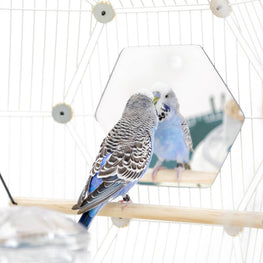Budgie Perches
Budgies need perches for sleeping, playing, courting, singing and resting. They love flapping or climbing from one perch to another, and will spend much of the day with their four toes curled around a perch, so it’s important to give them some good ones. You should have at least two perches, even in a small cage, and they should be at different levels so that your budgie gets as much variety in their perching as possible.

Three young budgies test a natural wood perch out for size
Budgie Perch Types
It is best to avoid a smooth, rounded perch. Give the budgie’s feet something interesting to play on – one made from twisted twigs is a good option, or simply a customised stick. The bird will love chewing at the wood, and the rough surface is good for gripping. Pet shops stock plastic perches in interesting shapes, which are certainly better than plain, rounded wooden ones; but the rough-and-ready stick is still the best bet.
Budgie Perch Size
If you have a sufficiently large cage, vary the perch sizes. As long as there’s room for the bird to sit comfortably, the perch is useable. You can buy custom-sized ones for your cage; but the best ones are simple thin branches. These can be trimmed to size and inserted horizontally across the cage bars – versatile, and free! Your budgies’ favourite perches are usually the ones they roost on – and should be between 1 and 2cm diameter to make them perfect for budgie feet. In a larger cage you can include perches of different diameters to make things more interesting for the bird, or construct a vertical ‘twig tree’ with perches of various sizes
When adapting a large twig or small stick for a perch, give it a good scrub first. It’s just good practice to make sure anything introduced into the cage is thoroughly clean. Don’t use a strong detergent – just plain water and a light brush will suffice. Some owners clean their sticks in a very diluted bleach solution (100ml bleach to 2 litres water). If you do this, rinse the stick thoroughly afterwards.
Pouring boiling water over the stick will kill any microbes, just to be on the safe side. Always make sure the perch is completely dry before introducing to the cage – in the absence of direct sunlight, 20 minutes in an oven at 90C (200F) will do the job. Giving it a blast in the oven will also ensure there is nothing left alive either outside or inside the wood. Just make sure it’s cooled off before sticking it in the cage!
Over time a twig-perch will need to be replaced (usually because the budgie has chewed his way through it). When you introduce a new one, don’t be surprised if your birds seem a little wary at first. It’s a great budgie irony that they like things to be changed around a bit, but often take time getting used to the change.

The rough-and-ready stick perches are often the favourites
Budgie Perch Stand
If your pet budgies have been finger-trained and can leave their cages to free-fly indoors, they will need places to perch. Once the birds are completely tame they will use you as the perch, and will happily play on the floor too, however it is still good for them to have non-human perches in the room.
You can buy ready-made perch stands of all shapes and sizes. You can also extend your budgerigar DIY to this area and make your own. At its most basic a perch stand is a bent twig embedded in a flat base; but if you feel so inclined you can build a miniature playground for your birds, incorporating ladders, climbing frames and perches.
Perch Covers
If you’re using plain wooden perches made from pine dowelling, most pet-shop literature will recommend putting covers on them. These are custom-made tubes of sandpaper which fit over the perch and give your bird’s feet a bit more grip and texture. They will also tell you how these help keep your bird’s toenails at the right length, but this is not actually true. Like feathers, the nails of a budgie reach the correct length and then remain at that length unless they are snapped off, or if the bird has a disease or condition associated with excessive nail growth.
The truth is, perch covers are not necessary. They may even be a cause of a budgie condition known as bumble foot, where the toes become swollen and sore.
What Wood is Safe for Perches?
If you’re sourcing your own ‘wild’ sticks, you need to avoid any wood that might be toxic. It’s best to stick to native tree species, mainly because not all ornamental woods have been tried and tested in budgie cages. However, these common non-native species are also safe to use:
Almond, Bamboo, Cottonwood, Douglas fir, Dracaena, Eucalyptus, Fig, Ginkgo, Grape vines, Hibiscus, Hickory, Lemon, Lime, Orange, Palm, Tree fern, Yucca.
Unsafe Wood for Budgies
Rather than list hundreds more ‘budgie safe’ trees, it’s far more useful to have an ‘avoid’ list. The following common wild, garden and parkland species have been implicated in budgie health problems, so don’t use any of these as perches:
Alder,
Apricot, Azalea, Box elder, Boxwood, Buckthorn, Burdock, Cedar, Elder, Heather, Holly, Horse chestnut, Huckleberry, Hydrangea, Jasmine, Juniper, Laburnum, Laurel, Mango, Myrtle, Nectarine, Nutmeg, Oak, Mistletoe, Oleander, Peach, Plum, Privet, Rhododendron, Sage, Tobacco, Walnut, Witch hazel, Wisteria, Yew.
Driftwood found on a beach will always be tempting as a cage ornament, but because you can’t always tell which species the wood came from, nor the toxic things it might have been in contact with, it’s best to avoid introducing it to cages.




